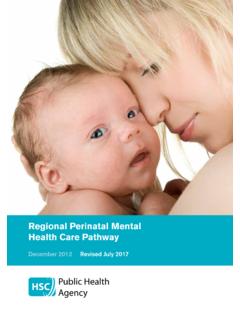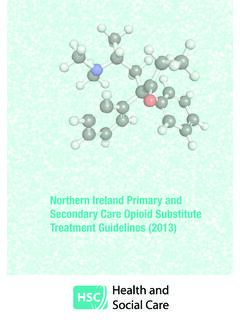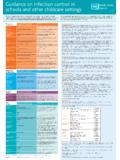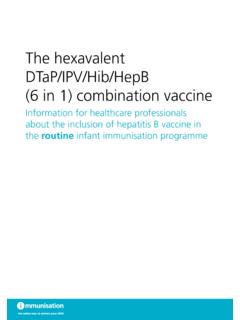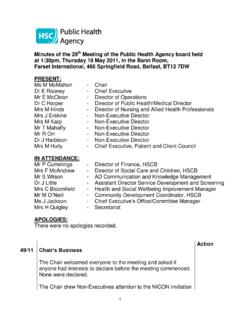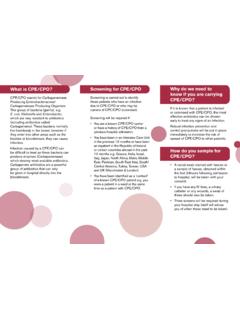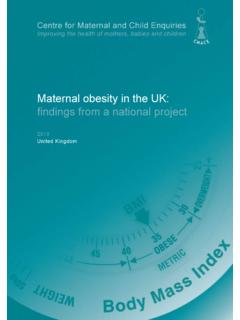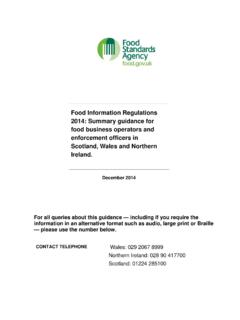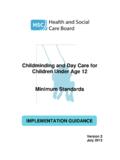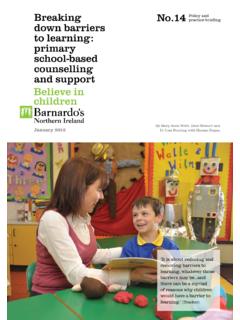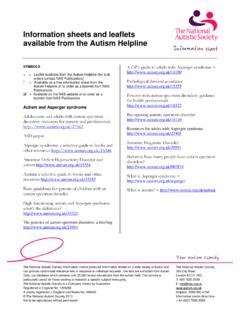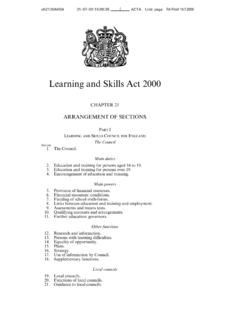Transcription of Healthier lunch boxes - HSC Public Health Agency
1 Healthier lunch boxes Contents Introduction 3. Benefits of promoting Healthier lunch boxes 3. What should be in a Healthier lunchbox? 4. Step by step plan 6. Healthier lunch box checklist 14. Integrating with other school food projects 15. Curriculum links 17. References 18. Sources of further information 20. Introduction Benefits of promoting Healthier lunch boxes This Healthier lunch box Promoting Healthier lunch boxes can: guidance highlights easy encourage pupils' interest in making Healthier choices about ways for your school to their diet;. promote Healthier food and support the Department of Education's nutritional standards for drink choices in lunch boxes . school lunches;. encourage a whole school approach to healthy eating;. It looks at how you can work increase the contact between school and home;. with parents and carers, and support your school 's community links;. the wider school community, give parents relevant information on aspects of food and Health .
2 To ensure that consistent Why focus on Healthier lunchboxes? food and nutrition messages A lunch box provides a valuable contribution towards a child's are communicated. nutritional requirements for a day. According to the Department of All meals provided to school Education's 2008 school census , over 127,000 children in Northern children must comply with Ireland (42% of pupils present) took a packed lunch to the nutritional standards for An all-island study (2005) looking at the nutritional balance of school You can over 2,500 school children's packed lunches found that 9 out of every 10 lunch boxes (92%) contained foods high in fat and support these standards by Almost half of all packed lunches (47%) had no portions of looking at how they can be fruit and vegetable and over two thirds of lunch boxes (71%) did not translated across to Healthier meet the compulsory school meals standards for Northern Ireland.
3 lunch boxes in your school . Similar research conducted by the Food Standards Agency in 2004 also indicated that children who take a packed lunch to school are eating far too much fat, saturated fat, salt and sugar in one The survey also revealed that under a fifth of lunch boxes (16%) did not contain any starchy food such as sandwiches, pasta or rice, and that just under half the lunch boxes surveyed (48%) did not contain a portion of fruit or chopped vegetables. Three out of four lunch boxes (74%) also failed to meet the nutritional standards set in 2001 for England's schools meals. Clearly, there is a need to make lunch boxes Healthier and more appetising to pupils. But this does not mean that they should miss out on all the things that they enjoy eating. Variety is the key to a Healthier lunch box. It is all about getting a balance and a good variety of foods over a period of time, for example a week.
4 No single food can provide all the essential nutrients that the body needs. 3. What should be in a Healthier lunch box? A Healthier lunch box should be based on the eatwell plate food groups (see ), which promote balance and variety in the diet. Parents and pupils should try to include something from each of the eatwell food groups in the lunch box and ensure that this includes a drink. Bright and colourful foods with different tastes and textures should be encouraged. Fruit and vegetables do this naturally. If the food looks good then the chances are that children will want to try it. There are many ways to keep the lunch box exciting, for example adopt a colour theme for each day, take inspiration from holidays or different countries and foods that are in season or grown in the school or home garden. Foods that a healthy lunch box should include A good portion of starchy food, for example wholemeal roll or bread, wraps, pitta pocket, pasta or rice salad.
5 Plenty of fruit and vegetables, for example an apple, satsuma, handful of cherry tomatoes or carrot sticks, mini-can of fruit chunks in natural juice or a small box of raisins. A drink of semi-skimmed milk or a portion of dairy food, for example individual cheese portion or pot of yogurt. A portion of lean meat, fish, eggs or beans, for example ham, chicken, beef, tuna, egg or hummus. A drink, for example unsweetened fruit juice, semi-skimmed milk or water. Foods that should be limited Remember, foods high in fat and sugar should be restricted. Nutritional standards for schools lunches do not allow sweets, chocolate or savoury snacks such as crisps, fizzy drinks and other high sugar drinks to be served at lunch Any lunch box guidance or policy should reflect this. Treats can be included at lunch time; however, plain or lower sugar varieties should be encouraged. For more information on what to have in a lunch box refer to the school food: top marks' lunch box leaflet, Are you packing a healthy lunch ?
6 (available at ). 4. Case study One school nutrition action group (SNAG) at a primary school has built on its previous work of involving the whole school community in Health issues by setting up a Healthier lunch box challenge day. The day included a massive picnic on the school field with pupils, staff, parents and invited guests, including the local MP. It was a lively and enjoyable social occasion. We would definitely repeat this event, even though it was a lot of work and organisation. Children, staff and parents have responded positively and everyone has done their bit to make the day a success. Certainly the children are more knowledgeable now about Healthier eating and making food choices and I think the staff and parents are too. Head teacher Are you packing a healthy lunch ? 5. Step by step plan 1. Getting started As Healthier lunch boxes are an important aspect of food and drink provision in your school , a good start is to think about them as part of your whole school approach.
7 lunch box issues should be considered by the school council or SNAG, particularly involving pupils and parents. A whole school approach allows you to: outline to parents, staff and pupils the school 's expectations of what constitutes a Healthier lunch box;. help parents and pupils put together a lunch box which is Healthier and realistic;. set up a standard, consistent approach to the issue of food in your school ;. promote the fact that your school takes the Health of its pupils seriously. To do To find out what is required you could conduct an audit of lunch box contents before you start your Healthier lunch box promotion. The audit will give you a baseline from which you can see if any changes occur as a result of promoting Healthier lunch boxes . Ask pupils who have a lunch box to write down the contents of their lunch box for a day. Analyse the responses. The results will highlight the least and most consumed food groups and might indicate that you need to place an emphasis on encouraging pupils to eat more fruit and vegetables or have a drink at lunch time.
8 Use the information to plan and undertake your Healthier lunch box activities. 6. 2. Raise awareness When planning Healthier lunch box activities, you need to ensure that you communicate a consistent message to everyone involved in your school . By using the school food: top marks'. lunch box leaflet and other resources you will ensure that consistent healthy eating messages about lunch boxes can be delivered throughout your school . Pupils like to be involved in making choices, so why not encourage them to help? At school this might involve making lunch box items or trying new foods as part of a healthy eating topic. At home, pupils could be encouraged to help with the food shopping or help make the contents of their lunch box wherever possible. You could try A Healthier lunch box assembly. A Healthier lunch box buffet for parents, children and local organisations. Running a theme day at school to motivate parents and pupils.
9 You could try a Fruit Friday', a Red food day', a non-sandwich day or a Funky food Friday'. Implementing a whole school Health day or week. You could focus on all aspects of Health , including physical activity. Including top tips for parents about Healthier lunch boxes in your school newsletter, website, prospectus or brochure. Seeking parents' and pupils' opinions about Healthier lunch boxes . What support would they like? This could be identified through a simple questionnaire or at a parents' evening. Explaining to parents and pupils what you want to achieve and why. For example, you want to ensure that all the children in your school are fit and healthy. Stressing the importance of a balanced and varied diet. Do not ban certain food items (unless on grounds of safety, for example peanuts and risk to allergy sufferers). Be positive and promote best practice. One approach might be to promote a Healthier lunch box checklist for parents.
10 Focusing on food safety. Give ideas and tips on how to keep lunch boxes and drinks bottles clean and safe. 7. Step by step plan 3. Communicate with parents Parents play an important and influential role in determining their child's food and drink choices and preferences. Information to parents needs to be consistent, helpful and realistic. Approaches will differ between primary and post-primary schools, but ultimately the goal is the same to promote a healthy lifestyle. It is important to communicate to parents all of the elements that could contribute to Healthier lunch boxes . Also consider working with Health professionals such as community dietitians, school nurses, and community dental teams. Examples of good communication ideas Providing Healthier lunch box information to all parents by sending out the school food: top marks' healthy lunch box leaflet, Are you packing a healthy lunch ?
